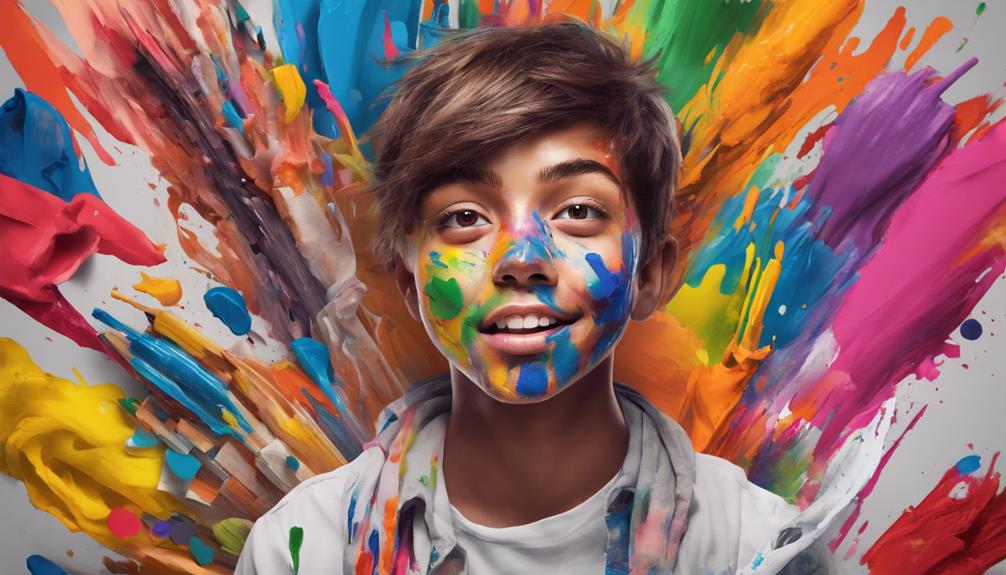In a school setting, fostering creativity in projects is essential for developing critical thinking skills and innovative approaches. By exploring unconventional ideas and presentation methods, students can elevate their projects beyond the ordinary. From utilizing multimedia tools to incorporating unique storytelling formats, the possibilities for creativity are endless. By delving into collaborative project ideas and integrating technology innovations, students can push the boundaries of traditional assignments. The quest for creativity in school projects is not just about meeting requirements but about transcending them to create something truly remarkable.
Key Takeaways
- Utilize mind mapping and SCAMPER technique for innovative idea generation.
- Incorporate multimedia tools to enhance project creativity and presentation quality.
- Engage in collaborative strategies like group brainstorming and role-playing for diverse perspectives.
- Leverage virtual collaboration tools for real-time communication and streamlined group work.
Creative Brainstorming Techniques
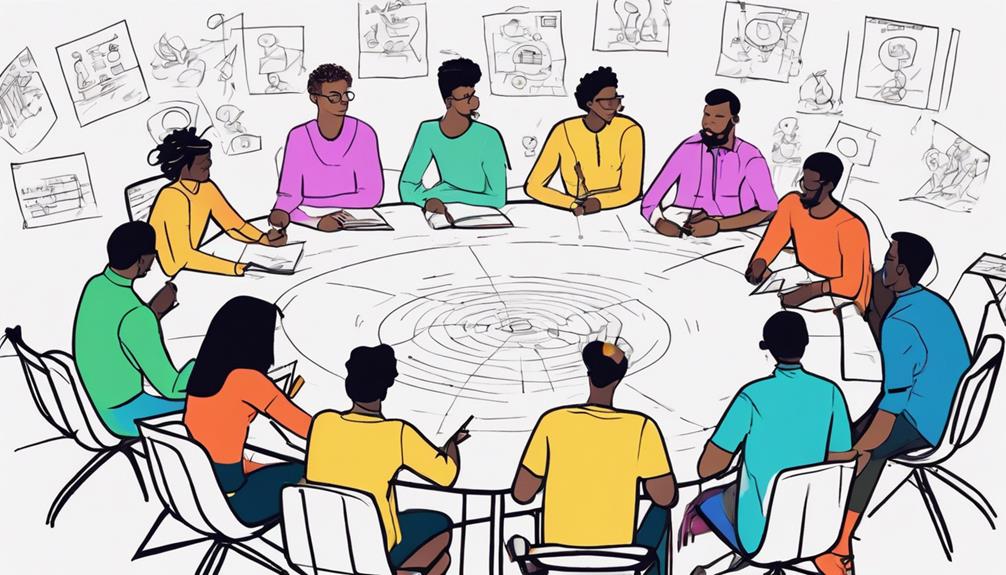
When embarking on school projects requiring creativity, employing structured techniques such as mind mapping, SCAMPER, 'Six Thinking Hats,' the 'Random Word' approach, and group brainstorming can significantly enhance the ideation process. Creativity is a crucial aspect of school projects as it involves thinking outside the box to generate unique and innovative ideas. Brainstorming techniques play a pivotal role in fostering creativity by providing structured methods to explore different perspectives and generate diverse ideas.
Mind mapping enables students to visually organize their thoughts and ideas, facilitating a clear understanding of the project's scope and potential connections between different concepts. The SCAMPER technique encourages students to think creatively by prompting them to Substitute, Combine, Adapt, Modify, Put to other uses, Eliminate, or Reverse elements of their project. 'Six Thinking Hats' method aids in approaching problems systematically by considering various aspects such as creativity, facts, emotions, benefits, cautions, and process. The 'Random Word' technique triggers creative thinking by linking a randomly selected word to the project, stimulating new ideas. Group brainstorming sessions leverage the collective creativity and diverse perspectives of team members, fostering collaborative idea generation for school projects.
Utilize Multimedia Tools
Employing multimedia tools in school projects can enhance the visual appeal and engagement of presentations, offering diverse options for creating dynamic and interactive content. Multimedia tools like Adobe Creative Suite, Canva, and Prezi provide avenues for students to express their creativity in the classroom through various mediums. By incorporating multimedia elements such as videos, animations, and interactive graphics, students can elevate the quality of their project ideas and capture the audience's attention effectively. This approach allows for the integration of multiple forms of media, making the project more dynamic and interactive for viewers. Additionally, multimedia presentations cater to different learning styles, providing a multi-sensory experience that aids in better understanding and retention of information. Overall, leveraging multimedia tools not only enhances creativity in the classroom but also fosters a more engaging and impactful school project experience.
- Multimedia tools offer diverse options for creating engaging projects.
- Incorporating videos, animations, and interactive graphics enhances presentation quality.
- Integration of various forms of media makes projects more dynamic.
- Multimedia presentations cater to different learning styles.
- Students can express creativity through diverse mediums.
Collaborative Project Ideas
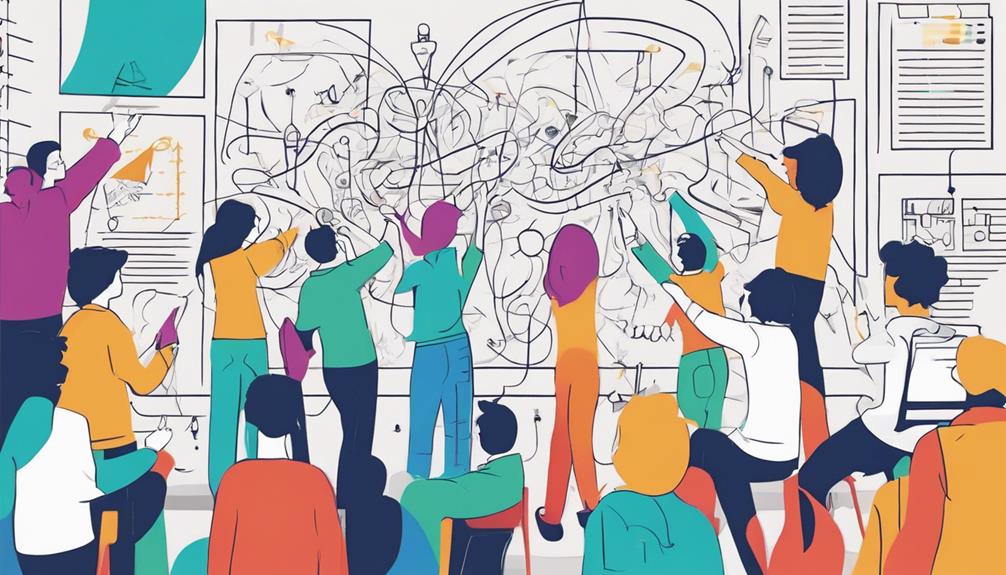
The effectiveness of collaborative projects in schools relies on utilizing group brainstorming techniques and virtual collaboration tools to enhance student engagement and learning outcomes. By incorporating these strategies, students can harness the power of collective intelligence, diverse perspectives, and shared resources to tackle complex problems and generate innovative solutions. Implementing these collaborative project ideas fosters a dynamic learning environment that cultivates creativity, critical thinking, and teamwork skills among students.
Group Brainstorming Techniques
Utilizing various structured brainstorming techniques is essential for cultivating creativity and collaboration within group projects, leading to the generation of innovative and unique ideas.
- Mind mapping, round-robin, and brainwriting are effective techniques for generating creative ideas in a group setting.
- Open communication and active participation among group members foster creativity and collaboration during brainstorming sessions.
- Techniques like SCAMPER (Substitute, Combine, Adapt, Modify, Put to another use, Eliminate, Reverse) can spark creative thinking and generate unique project concepts.
- Role-playing or scenario-based exercises stimulate diverse perspectives within the group, leading to more creative project outcomes.
- Structured methods such as Six Thinking Hats or SWOT analysis facilitate organized and strategic idea generation in group projects.
Virtual Collaboration Tools
Virtual collaboration tools serve as indispensable assets for enhancing student engagement and productivity in collaborative project endeavors. Students benefit from the real-time communication and project management capabilities offered by platforms such as Google Workspace, Microsoft Teams, and Slack. These tools enable seamless collaboration on shared documents, presentations, and discussions. Additionally, features like video conferencing, instant messaging, file sharing, and task assignment streamline group work and boost overall productivity. Virtual whiteboards and project management tools like Trello and Asana further aid in organizing tasks, tracking progress, and fostering teamwork in virtual environments. By leveraging these tools, students can brainstorm ideas, provide feedback, and work together on innovative projects regardless of their physical locations, promoting creativity and enhancing the collaborative project experience.
Incorporate Visual Storytelling
Enhancing school projects with visual storytelling can significantly elevate the effectiveness of conveying information and engaging audiences. Visual storytelling in school projects involves using images, graphics, and videos to convey a narrative. Infographics are a powerful tool for visual storytelling, presenting information in a visually appealing and easy-to-understand format. Storyboarding helps plan out the visual elements of a project, outlining the sequence of images or scenes to tell a cohesive story. Incorporating color theory and design principles enhances the visual impact of storytelling elements in school projects. Utilizing multimedia tools such as presentations, digital storytelling platforms, and interactive visuals can make school projects more engaging and creative. By integrating these visual storytelling techniques, students can create more compelling and informative projects that capture the audience's attention effectively.
Unique Presentation Formats
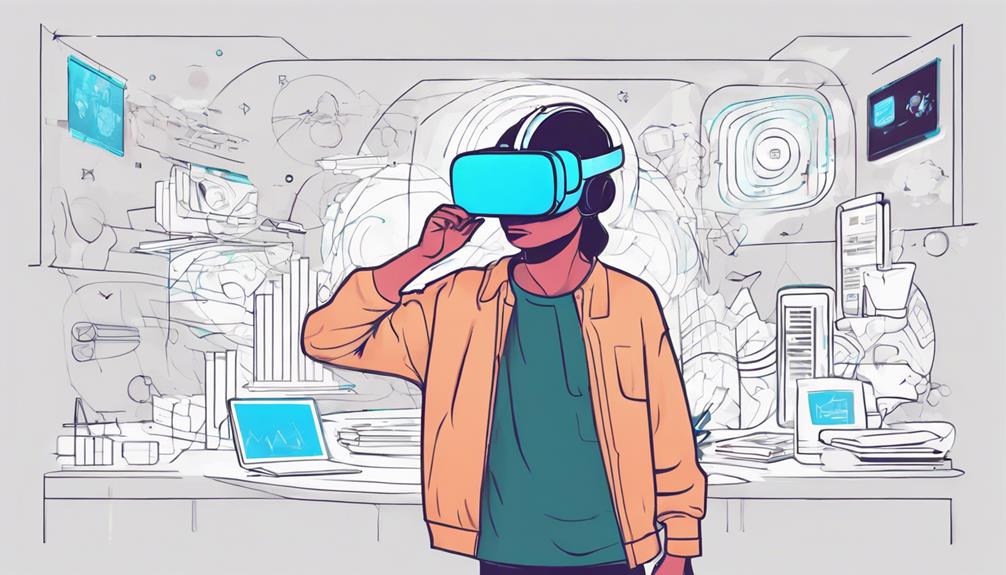
In exploring unique presentation formats, it is essential to consider engaging strategies like choose-your-own-adventure scenarios, PechaKucha presentations, storytelling techniques, virtual or augmented reality experiences, and gamification elements. These methods offer opportunities to captivate audiences through interactivity, concise delivery, compelling narratives, immersive experiences, and enhanced participation. By embracing such innovative approaches, presenters can elevate the impact and memorability of their school projects.
Visual Storytelling Techniques
Visual storytelling techniques offer a dynamic approach to presenting school projects, engaging audiences through innovative and captivating narrative formats. When incorporating visual storytelling into your projects, consider the following techniques:
- Utilize comic strips and graphic novels to appeal to different learning styles.
- Incorporate interactive timelines and infographics for a dynamic and easy-to-understand presentation.
- Experiment with stop-motion animation or video storytelling to bring your project to life.
- Explore digital storytelling tools like Adobe Spark or Canva for visually stunning multimedia presentations.
- Implement virtual reality (VR) or augmented reality (AR) experiences to provide a unique and interactive storytelling experience.
These techniques can enhance the effectiveness of your project presentations by making them more engaging and memorable.
Interactive Digital Platforms
Utilizing interactive digital platforms revolutionizes traditional presentation methods, offering students dynamic and engaging formats to showcase their school projects. Platforms like Prezi, Canva, and Piktochart enable students to infuse creativity into their presentations through multimedia elements such as videos, animations, and audio. By incorporating interactive features like clickable links, embedded quizzes, and interactive maps, students can enhance audience engagement and create memorable experiences. These platforms provide templates and design tools that empower students to customize their presentations, making them visually appealing and unique. The use of interactive digital platforms not only adds a layer of dynamism to school projects but also improves the effectiveness of conveying information to the audience, ultimately elevating the overall quality of the presentation.
Hands-On Project Demonstrations
To effectively elevate the presentation of school projects, incorporating hands-on project demonstrations offers a unique and engaging approach that captivates classmates and enhances the practical application of the project's concepts.
- Enhance Understanding: Use props, prototypes, or physical models to make project concepts more tangible.
- Interactive Activities: Demonstrate practical applications through interactive activities or simulations.
- Audience Engagement: Encourage classmates to interact with project elements for active participation.
- Showcase Creativity: Utilize hands-on demonstrations to showcase creativity, innovation, and problem-solving skills effectively.
- Memorable Experience: Make your project memorable by bringing it to life with hands-on elements that leave a lasting impression.
Out-of-the-Box Research Methods
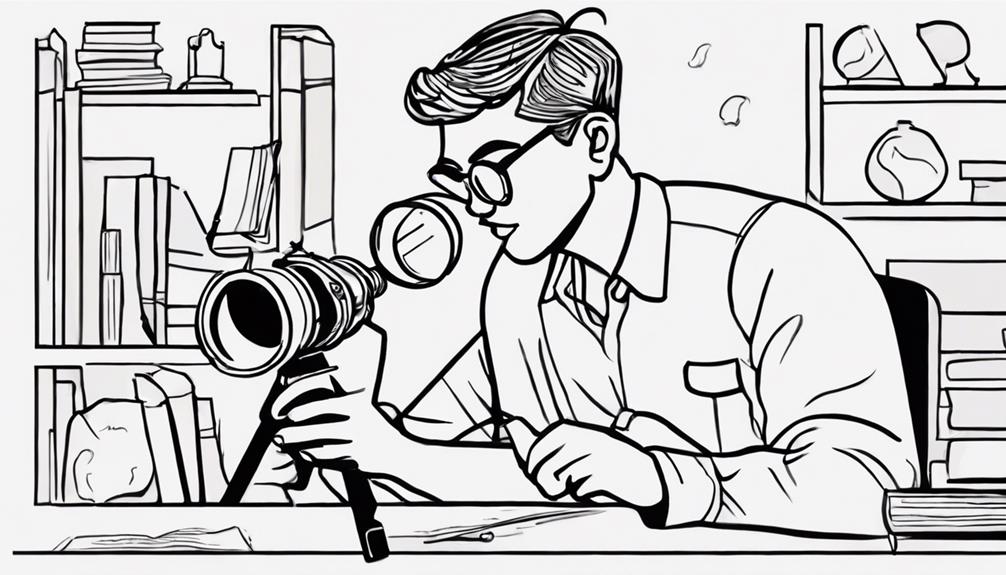
Innovative research methods play a crucial role in expanding the depth and breadth of insights gained during academic investigations. To inspire creativity and adapt to the flexible classroom environment, students can experiment with unconventional sources like interviews, surveys, and observations to gather unique perspectives for their research. Additionally, incorporating creative methods such as visual research, mind mapping, concept mapping, and role-playing can enhance their understanding of the topic in novel ways. Digital tools like social media analytics, online forums, and data visualization software offer opportunities to explore new data sources and present findings innovatively. Employing mixed-method approaches that combine qualitative and quantitative data collection techniques can provide a comprehensive view of the research topic. Furthermore, students can explore interdisciplinary strategies by integrating knowledge and methods from various fields to offer a fresh and multifaceted approach to their school projects.
| Innovative Research Methods | Benefits |
|---|---|
| Unconventional sources | Unique perspectives |
| Creative methods | Enhanced understanding |
| Digital tools | Innovative data exploration |
| Mixed-method approaches | Comprehensive insights |
| Interdisciplinary strategies | Fresh and multifaceted approach |
Gamification in Projects
Exploring the integration of gamification elements in academic projects enhances student engagement and motivation levels. Gamification in projects involves incorporating game elements like point systems, challenges, and rewards to enhance participation and foster creativity in school projects. Here are some key points to consider:
- Enhanced Engagement: Gamification provides a sense of accomplishment and progress tracking, motivating students to actively participate in their projects.
- Boosted Creativity: By introducing game-like features such as levels and badges, students are encouraged to think creatively and approach tasks in innovative ways.
- Improved Problem-Solving Skills: Gamification encourages students to tackle challenges within projects, enhancing their problem-solving abilities.
- Sustained Interest: Features like leaderboards create a competitive yet friendly environment that keeps students interested and committed to completing their tasks.
- Positive Learning Outcomes: Research indicates that gamification in education can lead to increased performance, higher retention rates, and a more positive learning experience overall.
Incorporating gamification in academic projects can significantly impact student engagement, creativity, and overall project outcomes.
Interactive Digital Solutions
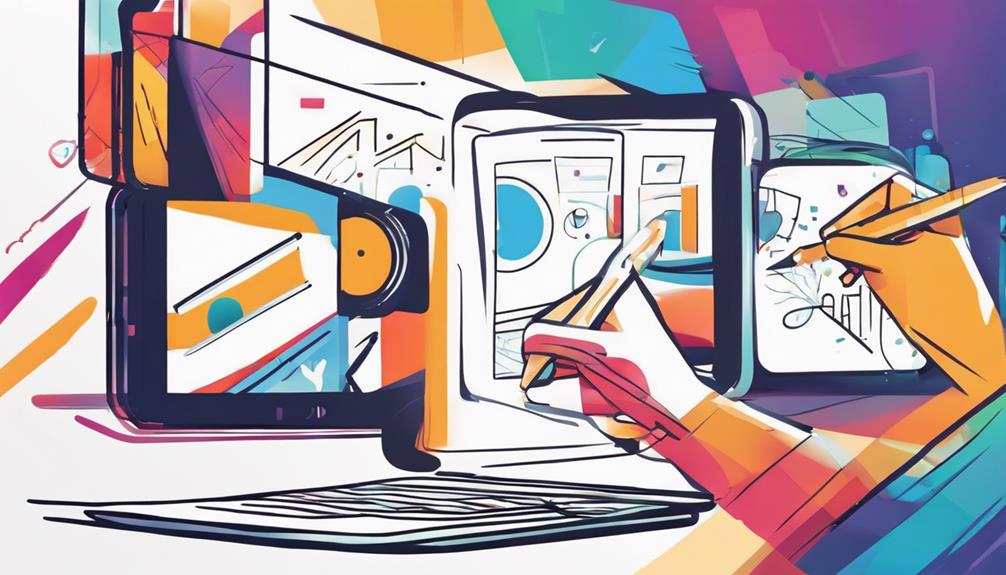
Utilizing interactive digital solutions in academic projects enhances student engagement and facilitates the creation of dynamic and immersive learning experiences. These solutions, such as websites, blogs, and infographics, incorporate multimedia elements like videos, animations, and interactive features to make learning more interactive. In the classroom environment, virtual museums, galleries, and events can be developed as innovative digital projects, providing students with opportunities to showcase their knowledge and creativity in a unique way.
Moreover, projects like digital escape rooms and augmented reality experiences offer hands-on learning opportunities that actively engage students in the learning process. By using web-based learning modules, students can explore various topics in a visually appealing and interactive manner, enhancing their understanding and retention of the material. Overall, integrating interactive digital solutions into academic projects not only fosters creativity but also helps students develop essential skills in a technology-driven world.
Infuse Artistic Elements
Incorporating artistic elements like painting, drawing, and sculpture into school projects can significantly enhance creativity and visual appeal. By utilizing color schemes, textures, and patterns, students can add depth and interest to their work, making it visually engaging and memorable. Experimenting with various artistic techniques allows individuals to showcase their skills and creativity, fostering a more dynamic and expressive approach to project completion.
Visual Aids Effectiveness
Artistic elements integrated into visual aids significantly enhance the effectiveness of conveying complex information and concepts in school projects, fostering engagement, retention, and critical thinking among students. When infusing visual aids with creative designs, several key benefits emerge:
- Enhanced Engagement: Artistic visuals captivate students' attention and make the content more interesting.
- Improved Retention: Creative designs aid in memory recall, making it easier for students to remember the information.
- Facilitates Understanding: Complex concepts become more digestible and easier to comprehend through artistic representations.
- Stimulates Critical Thinking: Visual aids with artistic elements prompt students to analyze information from different perspectives.
- Effective Communication: Artistic visual aids serve as powerful tools to convey ideas effectively, ensuring the message is communicated clearly.
Color Psychology Impact
Color psychology plays a pivotal role in school projects, exerting significant influence on emotions, behavior, and learning outcomes. Understanding how different colors evoke specific feelings and associations is crucial in creating impactful projects. Warm colors like red and yellow have been shown to stimulate energy and creativity, making them ideal for sparking innovative ideas. On the other hand, cool colors like blue and green promote calmness and focus, which can be beneficial for enhancing concentration during learning activities. Utilizing complementary color schemes not only creates visual harmony but also enhances the aesthetic appeal of the project, contributing to a more engaging presentation. By incorporating color psychology effectively, students can convey messages more powerfully and foster creativity in their school projects.
Real-World Application Projects
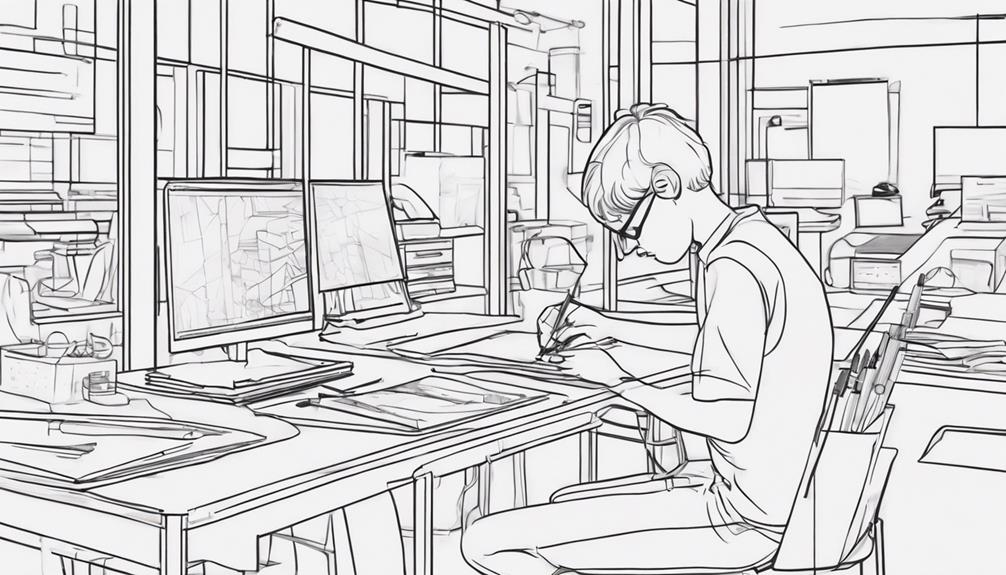
Real-world application projects in educational settings serve as practical opportunities for students to synthesize classroom knowledge with authentic challenges. These projects bridge the gap between theory and practice, fostering creativity and critical thinking through hands-on experiences. Here are some key insights into the significance of real-world application projects:
- Integration of Knowledge: Students apply theoretical concepts to real-life situations, enhancing their understanding of the subject matter.
- Problem-Solving Skills: Engaging with authentic challenges hones students' ability to analyze problems and develop innovative solutions.
- Preparation for the Future: By working on projects that simulate real-world scenarios, students gain valuable skills and experiences for their future careers.
- Enhanced Learning: Practical application deepens comprehension and retention of concepts, offering a more holistic educational experience.
- Creativity Development: Encouraging students to think outside the box and explore novel solutions nurtures their creative capabilities, essential for success in diverse fields.
Real-world application projects play a pivotal role in cultivating well-rounded individuals equipped to tackle the challenges of the future.
Hands-On Experiments and Prototypes
Hands-on experiments and prototypes serve as essential tools for testing the viability and functionality of theoretical concepts. By engaging in the prototype testing process, students can refine their ideas, foster innovation, and enhance their problem-solving skills. The benefits of hands-on experiments include a deeper understanding of principles, increased creativity, and the opportunity to collaborate with peers to create tangible representations of abstract theories.
Prototype Testing Process
The implementation of prototype testing processes, involving the creation and evaluation of physical models or simulations, plays a pivotal role in enhancing the feasibility and functionality of student-designed projects. Through hands-on experiments and prototype testing, students can uncover design flaws early, iterate on their ideas, and enhance the overall quality and effectiveness of their projects. This process not only helps students visualize their projects but also enables them to gather feedback and make informed decisions on improvements or modifications. Engaging in hands-on experiments fosters critical thinking, problem-solving skills, and innovation, providing a practical approach to learning and enhancing creativity in school projects.
- Uncover design flaws early
- Iterate on ideas
- Enhance project quality and effectiveness
- Visualize projects effectively
- Foster critical thinking and innovation
Benefits of Experiments
The integration of hands-on experiments and prototype testing in educational projects not only enhances students' practical understanding of theoretical concepts but also cultivates their problem-solving abilities and fosters a mindset of continuous improvement. Hands-on experiments provide students with tangible experiences that deepen their comprehension of scientific principles. Prototypes serve as a platform for testing and refining ideas, nurturing creativity and honing problem-solving skills. These activities stimulate critical thinking, hypothesis testing, and data analysis, encouraging a scientific approach to learning. By constructing prototypes, students can apply abstract knowledge to real-world scenarios, effectively bridging the gap between theory and practical application. Engaging in experiments and prototype creation ignites curiosity, promotes innovation, and instills a profound appreciation for the subject matter.
Multicultural Perspectives in Projects
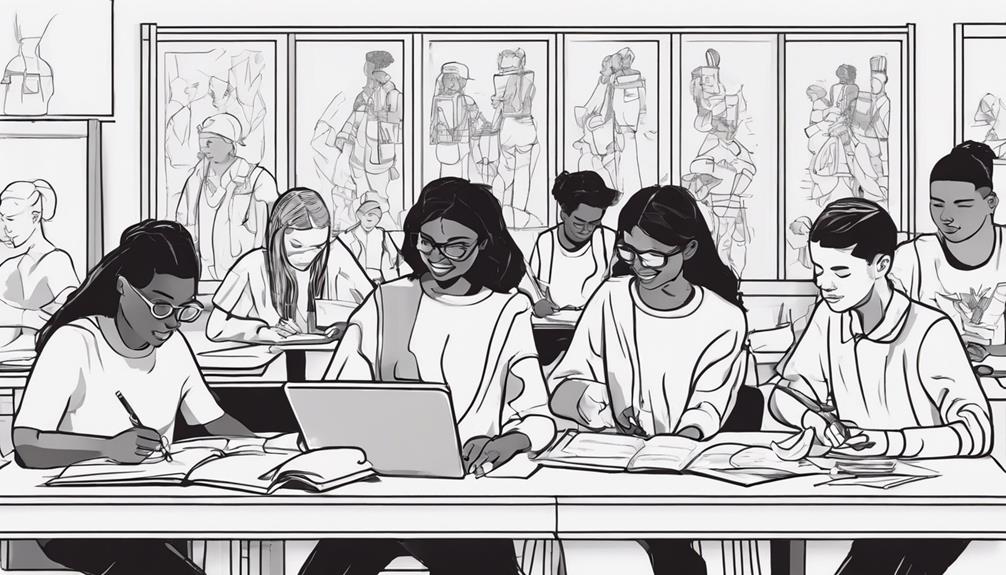
Embracing multicultural perspectives in school projects enhances students' understanding of diverse cultures and fosters a sense of global citizenship. By incorporating a variety of cultural viewpoints, students can benefit in several ways:
- Promoting Diversity: Multicultural projects celebrate the richness of different cultures, promoting diversity within the classroom and beyond.
- Enhancing Learning Experiences: Exposure to various traditions, beliefs, and customs enriches students' learning experiences, providing a broader perspective on the world.
- Encouraging Empathy and Respect: Multicultural projects cultivate empathy, respect, and appreciation for cultural differences among students, fostering a more inclusive environment.
- Fostering Global Awareness: Including diverse perspectives in projects prepares students for a multicultural society, nurturing a sense of global awareness and interconnectedness.
- Developing Critical Skills: Learning about various cultures through projects not only enhances creativity but also boosts critical thinking and communication skills, essential for success in a diverse world.
Integrating Technology Innovations
Utilizing modern technological advancements in educational settings can greatly enhance the creativity and engagement levels of students in school projects. By integrating tools like virtual reality, augmented reality, and interactive apps, students can immerse themselves in unique learning activities that stimulate their creativity and problem-solving skills. Additionally, incorporating coding and programming into projects enables students to develop interactive elements and innovative solutions, fostering a deeper understanding of technology and its applications in various fields.
To further enhance engagement, exploring digital storytelling through multimedia platforms can help students present information in captivating and interactive ways, making their projects more compelling. Online collaboration tools play a vital role in facilitating teamwork and communication among students, promoting a collaborative environment where ideas can flow freely. Moreover, implementing digital design software and 3D modeling programs in projects can elevate the presentations to visually stunning levels, capturing the attention of both peers and teachers.
| Technology Innovations | Benefits for School Projects |
|---|---|
| Virtual Reality | Immersive learning experiences |
| Augmented Reality | Interactive and engaging activities |
| Coding and Programming | Innovative solutions development |
| Digital Storytelling | Captivating presentation of information |
Sustainability and Eco-Friendly Projects
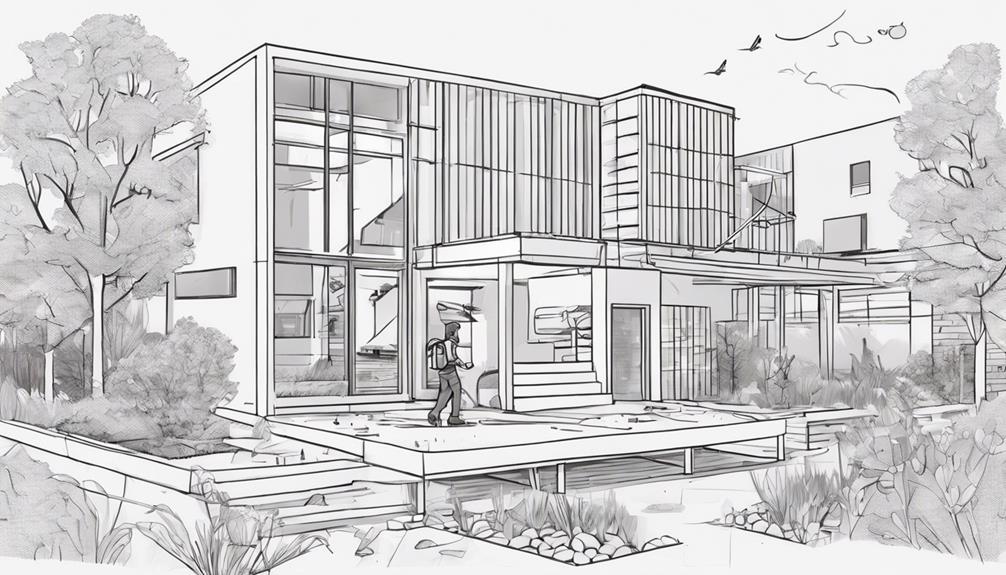
Exploring sustainable practices within school projects offers students the opportunity to actively engage in environmental conservation and foster a sense of responsibility towards reducing their ecological impact. By incorporating sustainability and eco-friendly initiatives into their projects, students create learning environments that not only benefit their academic growth but also contribute positively to the world around them. Here are key aspects to consider when undertaking sustainability and eco-friendly projects:
- Focus on Environmental Conservation: Emphasize the importance of reducing carbon footprint and promoting sustainable practices.
- Raise Awareness: Educate others about the significance of sustainable living and encourage the adoption of green initiatives.
- Explore Renewable Resources: Investigate renewable energy sources, waste reduction strategies, and sustainable agriculture methods.
- Utilize Eco-Friendly Materials: Incorporate environmentally friendly materials, establish recycling programs, and implement energy-efficient practices.
- Impact on Future Generations: Understand that sustainable projects can have a lasting positive impact on the environment, community, and future generations.
Creative Assessment Strategies
In educational settings, the implementation of innovative assessment strategies that prioritize creativity is crucial for fostering holistic student development. Creative assessment strategies involve incorporating project-based assessments that provide students with opportunities to showcase their creativity in the learning process. By utilizing rubrics that not only evaluate content knowledge but also assess creativity, originality, and innovation in student projects, educators can effectively gauge the depth of a student's creative abilities. Allowing students to select their project topics and formats encourages diverse and imaginative expressions of learning, fostering a sense of ownership and engagement in the assessment process. Moreover, encouraging students to reflect on their creative processes and problem-solving strategies utilized in completing their projects enhances their metacognitive skills. Providing constructive feedback that recognizes and values the creative aspects of student work reinforces the significance of creativity in academic assessments, ultimately nurturing a culture that appreciates and promotes creativity in education.
Frequently Asked Questions
How Do You Make a School Project Interesting?
To make a school project interesting, employ engaging brainstorming techniques that stimulate creativity and foster collaboration among peers. Utilize strategies such as mind mapping, SWOT analysis, or nominal group technique to generate diverse ideas and perspectives. Encouraging active participation and open communication during brainstorming sessions can lead to innovative project approaches and captivating content. Emphasizing collaborative efforts and collective input can enhance the overall quality and appeal of the project.
How Can Students Be Creative in School?
To foster creativity in school projects, students can engage in collaborative brainstorming sessions to generate innovative techniques and ideas. Encouraging unconventional approaches and artistic expression through hands-on projects and multimedia elements can enhance creative thinking. Providing students with choices in project topics and formats empowers them to explore diverse ways of expressing their creativity. By embracing collaborative problem-solving and diverse presentation styles, students can cultivate their creative skills effectively in the academic setting.
What Are Creative Ways to Present a Project?
In exploring innovative ways to present a project, consider interactive presentations and collaborative videos for engaging your audience. Visual storytelling and digital portfolios offer avenues for conveying information creatively and effectively. By incorporating multimedia elements such as videos, images, and audio, a project can be brought to life in a dynamic and compelling manner. Embracing these approaches can enhance the impact and engagement of your project presentations.
How Can I Improve My Creativity?
To improve creativity, individuals can engage in various activities such as brainstorming sessions, creative exercises, mind mapping, and employing innovation strategies. These techniques stimulate divergent thinking, encourage exploration of unconventional ideas, and enhance problem-solving skills. By embracing a mindset of curiosity and experimentation, individuals can unlock their creative potential, generate innovative solutions, and cultivate a unique approach to project development.
Conclusion
In conclusion, incorporating creative brainstorming techniques, multimedia tools, collaborative project ideas, visual storytelling, unique presentation formats, multicultural perspectives, technology innovations, and sustainability projects can enhance creativity in school projects. By embracing diverse approaches and fostering innovation, students can showcase their unique talents and abilities. According to a study by the National Endowment for the Arts, students who engage in creative projects show improved critical thinking skills and academic performance.
